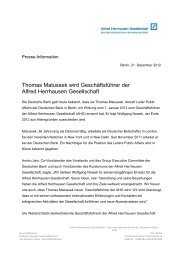India's role in a multi-polar world - Alfred Herrhausen Gesellschaft
India's role in a multi-polar world - Alfred Herrhausen Gesellschaft
India's role in a multi-polar world - Alfred Herrhausen Gesellschaft
Create successful ePaper yourself
Turn your PDF publications into a flip-book with our unique Google optimized e-Paper software.
38<br />
Through a billion voices: India’s <strong>role</strong> <strong>in</strong> a <strong>multi</strong>-<strong>polar</strong> <strong>world</strong><br />
on manufactur<strong>in</strong>g has led to both <strong>in</strong>ternal and external<br />
imbalances. The share of residential <strong>in</strong>come <strong>in</strong> GDP<br />
decl<strong>in</strong>ed by 18 per cent over the last 15 years; 2 that<br />
is, improvements <strong>in</strong> ord<strong>in</strong>ary people’s lives have not<br />
caught up with the country’s phenomenal pace of<br />
growth. Accord<strong>in</strong>gly, consumption as a share of GDP<br />
has decl<strong>in</strong>ed by 15 per cent <strong>in</strong> the same period. 3<br />
In expand<strong>in</strong>g <strong>in</strong>ternational trade, Ch<strong>in</strong>a has also<br />
accumulated large current account surpluses that<br />
have to be re<strong>in</strong>vested <strong>in</strong> developed countries,<br />
noticeably the United States, but with low returns.<br />
To ma<strong>in</strong>ta<strong>in</strong> a fixed exchange rate aga<strong>in</strong>st the dollar,<br />
the central bank has to accumulate large amounts of<br />
dollar reserves, which leads to constant <strong>in</strong>flationary<br />
pressure on the economy. Most economists <strong>in</strong> Ch<strong>in</strong>a<br />
agree that serious structural adjustments are needed<br />
to correct these imbalances and <strong>in</strong>creas<strong>in</strong>g domestic<br />
demand is at the core of this adjustment process.<br />
It has become common place for people to blame<br />
global imbalances on the <strong>in</strong>flexible exchange rate<br />
regimes of some surplus countries, most particularly<br />
Ch<strong>in</strong>a. In addition, holders of more extreme op<strong>in</strong>ions<br />
also po<strong>in</strong>t to Ch<strong>in</strong>a’s <strong>in</strong>flexible exchange rate regime<br />
as the root cause of unemployment <strong>in</strong> developed<br />
countries and the slow recovery <strong>in</strong> develop<strong>in</strong>g<br />
countries. 4 But historical evidence shows that<br />
exchange rate regimes have little to do with global<br />
imbalances. Germany and Japan both have a float<strong>in</strong>g<br />
regime, but both countries run very large surpluses.<br />
In particular, Japan has rema<strong>in</strong>ed a strong exporter<br />
despite the Plaza Accord forc<strong>in</strong>g the Yen to float and<br />
revaluate.<br />
Ch<strong>in</strong>a’s own experience s<strong>in</strong>ce 2005 also flies <strong>in</strong><br />
the face of this claim. Between 2005 and 2008, the<br />
Renm<strong>in</strong>bi appreciated by about 20%, but Ch<strong>in</strong>a’s<br />
trade and current account surpluses both surged.<br />
To blame the value of the Renm<strong>in</strong>bi for caus<strong>in</strong>g<br />
unemployment <strong>in</strong> developed countries is wrong. If<br />
global imbalances are not related to exchange rate<br />
regimes, employment will not pick-up even if the<br />
Renm<strong>in</strong>bi appreciates.<br />
The claim that a weak Renm<strong>in</strong>bi hurts Ch<strong>in</strong>a’s<br />
trade competitors has some merits. But one has<br />
to remember two th<strong>in</strong>gs. Firstly, the Renm<strong>in</strong>bi is<br />
only pegged to the dollar and floats aga<strong>in</strong>st other<br />
currencies together with the dollar. If the Renm<strong>in</strong>bi’s<br />
value is artificially low today, then there are other<br />
periods when it will be artificially high. For example,<br />
the Renm<strong>in</strong>bi was not devalued <strong>in</strong> the Asian F<strong>in</strong>ancial<br />
Crisis while most Asian currencies were.<br />
Secondly, it has to be remembered that there<br />
are costs associated with hav<strong>in</strong>g a fixed exchange<br />
rate regime, which other countries may not want<br />
to bear. For example, when liquidities are flow<strong>in</strong>g<br />
to emerg<strong>in</strong>g markets <strong>in</strong>clud<strong>in</strong>g Ch<strong>in</strong>a, a flexible<br />
exchange rate regime discourages the movement<br />
through revaluation of the home currency and avoids<br />
asset bubbles, but a fixed exchange rate regime<br />
cannot do this.<br />
So when we turn to Ch<strong>in</strong>a, we have to question,<br />
why it <strong>in</strong>sists on pegg<strong>in</strong>g its currency to the dollar.<br />
The cause is not mercantilism aimed at boost<strong>in</strong>g<br />
Ch<strong>in</strong>ese exports, as most like to believe. Experts<br />
and government officials <strong>in</strong>side Ch<strong>in</strong>a have realised<br />
that heavy reliance on exports is creat<strong>in</strong>g serious<br />
problems for the Ch<strong>in</strong>ese economy. In addition,<br />
moderate appreciation of the Renm<strong>in</strong>bi will not affect<br />
exports, as Ch<strong>in</strong>a’s experience between 2005 and<br />
2008 has shown.<br />
The Ch<strong>in</strong>ese central bank’s concern for the value<br />
of its dollar assets is another <strong>in</strong>validated argument.<br />
The fixed exchange rate forces the central bank to<br />
issue <strong>in</strong>terest-bear<strong>in</strong>g bonds to reduce the money<br />
supply caused by its purchase of dollars. The net<br />
impact of this on the central bank’s balance sheet is<br />
thus unclear. The only explanation is political. In other<br />
4 For the first claim, see Paul Krugman’s New York Times column, “Ch<strong>in</strong>ese New Year”, on January 1, 2010 at http://www.nytimes.com/2010/01/01/<br />
op<strong>in</strong>ion/01krugman.html. For the second claim, see Arv<strong>in</strong>d Subramanian’s F<strong>in</strong>ancial Times column, “It Is the Poor Who Pay for the Weak Renm<strong>in</strong>bi” on<br />
February 4, 2010 at http://www.ft.com/cms/s/0/fc056484-10fb-11df-9a9e-00144feab49a.html.<br />
Grow<strong>in</strong>g pa<strong>in</strong>s: global adjustment architecture | Yang Yao








